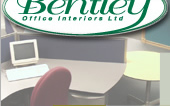GLOSSARY
OF TERMS
We
are aware that a number of terms are used in our industry
which may need some explanation:
Breakout
area
An
area for staff to sit with or without coffee/tea etc. for
a break from their tasks. Usually low seating with coffee
tables.
Cable
Management
The
part of the desk that plays the largest part in the decision
making process. Office furniture manufacturers spend vast
quantities of research and development funds creating ingeniuos
solutions to the cable management problem. Furniture buyers
study the options in minute detail and spend sleepless nights
worrying about which one to choose. Never actually used in
practice. See also cordless office.
Cellular
Office
What
the boss needs and you don't. Cellular offices are partitioned
private offices usually built from floor to ceiling and with
doors. They are particularly effective for people who do a
lot of private work, introverts, creative workers, ex-convicts
and agrophobics. May lead to feelings of isolation and paranoia.
See also open plan office.
Churn
Office
churn is the relocation of an individual or group of individuals
resulting in a change to the office environment. Not much
of a problem? Churn costs the UK economy around two billion
pounds a year. Over a third of office staff move or change
their workstation every year. Each move costs on average five
hundred pounds. If left unchecked, can lead to a feeling of
extreme poverty.
Club
Office
The
club office totally removes desk ownership. Instead of providing
workstations which are used for all job functions (meetings,
VDU work, paperwork etc.), areas are allocated on the basis
of job function over time. Different areas of the office are
dedicated as meeting spaces, computer rooms, private work
areas etc. Employees move through the office space to the
right location for the work in hand. The use of the term 'club'
also implies a relaxed, human environment with much use of
informal space for meetings and other work.
Combi-office
The
combi-office is an attempt to combine the best features of
both open plan and cellular layouts whilst mitigating their
disadvantages.
Cordless
Office
The
effect of cordless technology is to further free the worker
from the desk.
Downsizing
Making
people redundant. For the past decade, received management
wisdom has said that companies need to get leaner and meaner
if they are to succeed.
Empowerment
The
notion that to get the best out of the workforce management
must devolve decision making, involve and consult.
Ergonomics
The
study of how people relate to their environment. As far as
offices go this is usually depicted with a skeleton sitting
bolt upright at a computer desk. A common cause of injury
in office environments is the continuous use of specific muscle
groups in carrying out repetitive tasks.
Facilities
Manager
A
facilities manager may be either a board member or a janitor.
Their decision making power may range from total control of
all aspects of the office to none at all.
Feng
Shui
Chinese
art of creating harmonious working and living environment.
By harnessing the flow of the world's energy (chi), the right
environment promotes organisational and personal health, prosperity
and happiness. Feng shui is being taken seriously by an increasing
number of organisations.
Flexible
Working
A
catch-all term for any work practice that does not involve
'9 to 5' and/or going to an office as part of a daily routine.
Fractal
Office
How
offices can be looked at as small, independently functioning
teams (fractals) working in a seemingly chaotic fashion to
achieve common goals. Teams form and disband as needed - drawing
on skills of individuals rather than relying on flows of communication
through departments.
Hot
Desking
Hot
desking is characterised by the removal of ownership of individual
workstations. Instead, users have access to a pool of workplaces
on an ad hoc basis. Provision of workstations is based on
a calculation of an average user pattern and a factor for
any fluctuations in demand. Hot desking is likely to be only
part of an office layout - used mainly for sales teams, consultants
and teleworkers.
Hotelling
Basic
premise is the same as hot desking with the exception that
work areas are booked in advance for a set period of time.
Provides very effective use of space for mobile teams but
assumes that they are able to plan office needs in advance.
Advanced hotelling schemes include a concierge to 'personalise'
the work area for the person coming to work - laying out files,
favourite stationery...
Open
plan office
Offices
with desks grouped in an open floor layout with people segregated
by nothing more than low screens and storage are said to be
'open plan'. A good way of facilitating interdepartmental
communication and teamworking.
Planning
Office
planning is commonly the practice of fitting the greatest
number of desks into the smallest possible space. Space, light,
air and beauty are as important as a big desk.
Pod
A
cluster of up to eight workstations.
Sick
building syndrome
Sick
building syndrome costs the UK economy some eight billion
pounds a year. It is a physical and psychosomatic response
to unhealthy modern office environments with poor air conditioning,
poor light levels and poor ergonomics. The psychological element
is brought on by a lack of control of the environment. 'Smart'
light switches and 'smart' air conditioning are very clever
in providing an optimum level of human comfort but when employees
can't open the window on nice, sunny days they become downhearted
and go home sick.
Space
Efficiency
Space
efficiency is measured by dividing the total amount of worksurface
(desk space) by the total amount of usable floorspace in the
office. Although important, it is a peculiar obsession because
it often provides a pleasant and functional environment for
people to work in.
Touchdown
Derived
from the sport of American Football, touchdown is a term for
shared workstations for very short term use. Touchdown workstations
have small worksurfaces with either a networked PC or a connection
to a network for portable computers. Users access files, e-mail
messages, faxes etc. from the network for periods of a few
minutes at a time. The provision of touchdown areas also helps
to deal with potential overspill when demand for hot desks
outstrips supply.
Bentley
Office Services would like to thank President Office Furniture
for their permission in reproducing this glossary.









